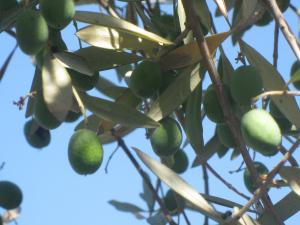
Olive Branches, photo by Martha Legg Katz
One of the reasons I wrote Being Both was to encourage more adult interfaith children to speak out about their own experiences, positive and negative. Too often, the discourse on interfaith marriage has been dominated by people speculating and worrying about the experiences of interfaith children, rather than listening to the voices of those who actually grew up in interfaith families.
So I was very glad to read a story in Haaretz this weekend about Jewish and Muslim interfaith families in Israel. The reporter actually interviewed not only parents, but at least two children from these families (ages 10 and 19) about their experiences and identities. The article adds to the small but important collection of stories told by interfaith children about their own lives in the 21st century (including the fifty interfaith children I surveyed for Being Both).
I appreciate the reporter and Haaretz for acknowledging that these intact interfaith families exist, for giving them space to tell their own stories, and for allowing them to describe both the challenges and the benefits of being intercultural, interfaith families. In the article, 10-year-old Nour says “I’m half-Jewish, half-Arab, and I’m not ashamed of it.” This is a strong statement from a very young person, given the history of conflict in the region. (And putting aside for a moment the fact that Arab is a language-group and ethnicity, not a religion, and that there are Jewish, Christian, and Muslim Arabic-speakers).
The article does have a certain amount of language derived from traditional anti-intermarriage discourse, including the idea that identity questions “plague” interfaith children “for life.” For the interfaith families in this article, I would argue that part of the stress clearly derives not from celebrating two religions, but from living in a war zone in which the parents are expected to identify with opposite camps. It is hard to keep straight the religious, cultural, ethnic, tribal, and national issues at play in this context. For instance, the reporter writes that one family observes “the holidays of both religions except…Independence Day.” Israeli Independence Day is not a Jewish holiday, it is a national holiday, even if some Jewish communities in the US choose to celebrate it.
But despite the complexity of this story, it is hard to ignore the voices of young people testifying to the benefits of growing up interfaith. We have young Nour, age 10, declaring that she “felt at home everywhere.” Reading her words, she does not sound plagued. She explains the issue here very succinctly, as she describes friends who gossip about her interfaith status: “I’d prefer to leave my parents the way they are, but it’s easier for friends when parents have the same religion.” In other words, she is comfortable with her interfaith family: the confusion, as I have so often written, is in the eye of the beholders.
In this article, an Israeli advocate for interfaith families, Irit Rosenblum, frets that sometimes these children choose a single religious identity in adulthood, and this can lead to a “break with one parent.” My point of view is that this break occurs only when parents cannot accept the reality that children, all children, whether interfaith or monofaith, can and will grow up to make their own religious choices. But Rosenblum also observes that some of these children lead “happy lives, content with both cultures,” and that while parents may struggle, “these children are more open to dialog and cultural receptivity, and they can more easily cross cultural divides.” It is heartening to observe that even in Jewish and Muslim interfaith families, even in the fraught atmosphere of Israel at the end of a very long summer, the idea that growing up in an interfaith family can have benefits as well as challenges can no longer be pushed aside or ignored.
Susan Katz Miller’s book, Being Both: Embracing Two Religions in One Interfaith Family is available now in hardcover and eBook from Beacon Press. You can also pre-order the paperback now.

